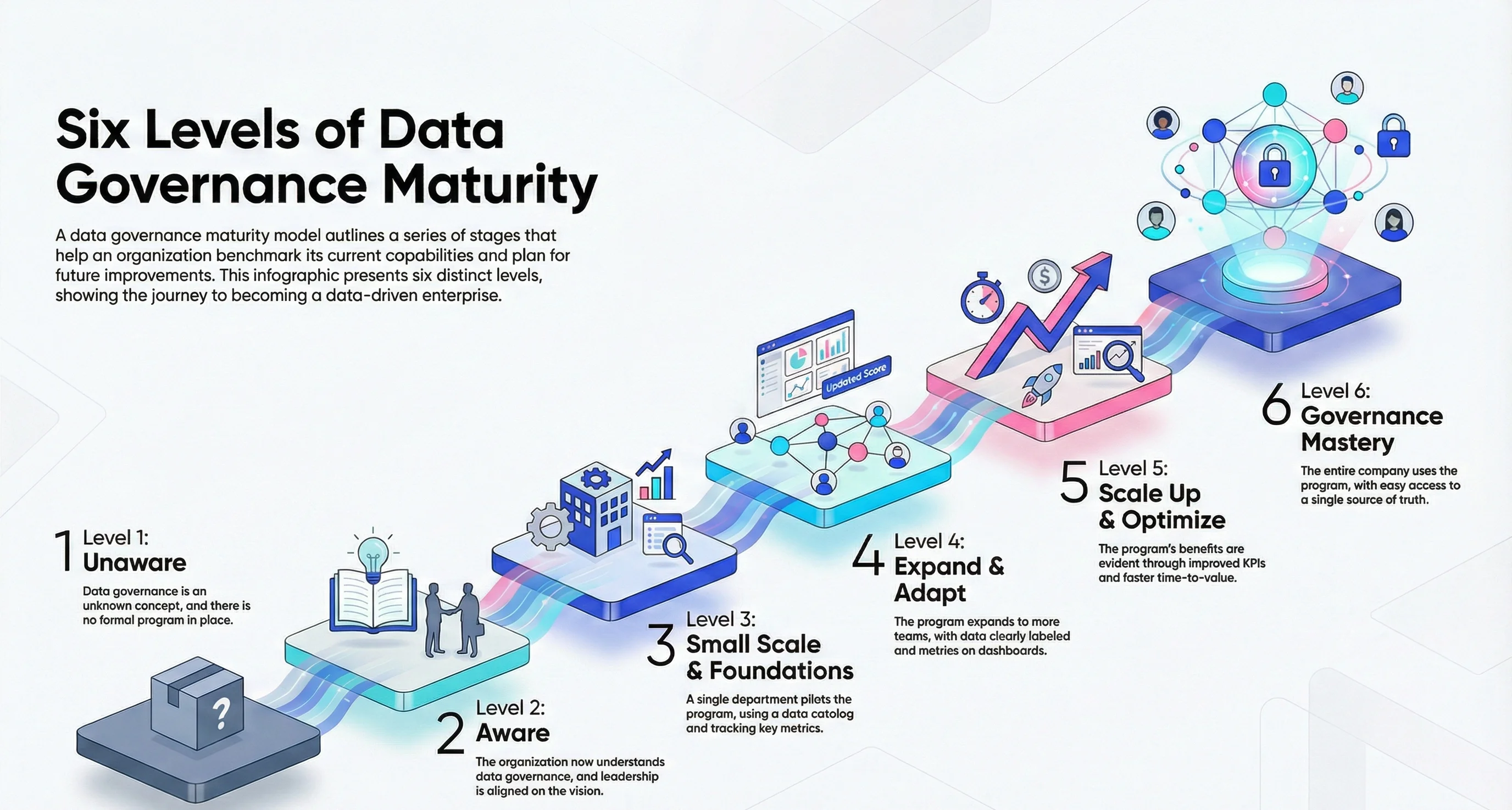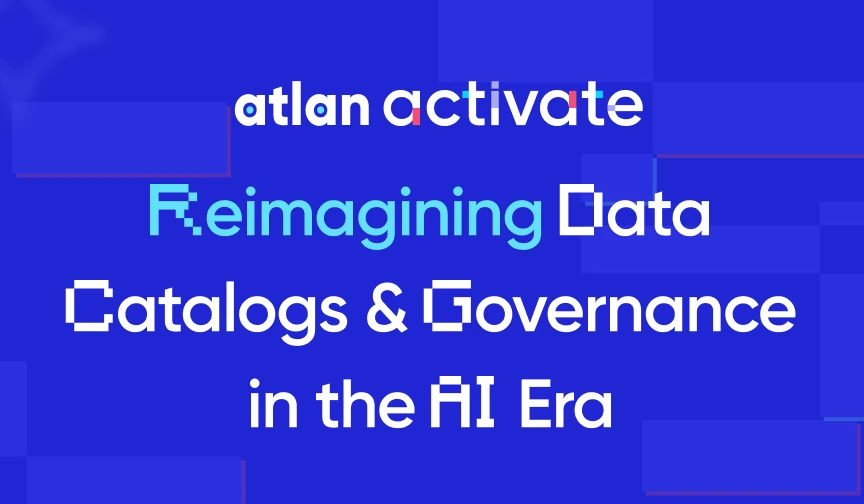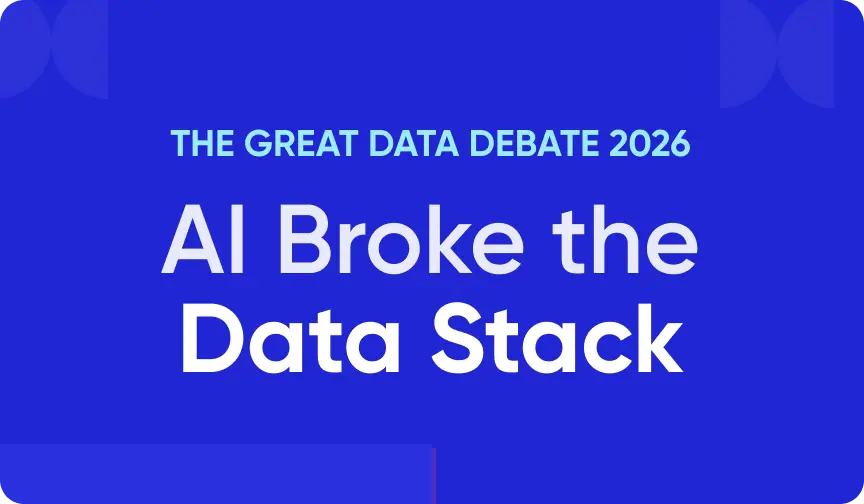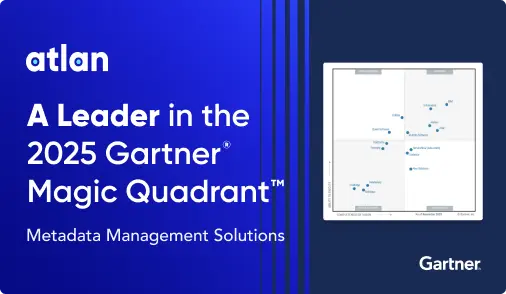Data Governance Maturity Model in 2026: A Practical Guide
How data governance maturity models work?
Permalink to “How data governance maturity models work?”Summarize and analyze this article with 👉 🔮 Google AI Mode or 💬 ChatGPT or 🔍 Perplexity or 🤖 Claude or 🐦 Grok (X) .
Data governance maturity models function as assessment and planning frameworks that translate complex governance capabilities into measurable, comparable stages. Organizations use these models to conduct structured evaluations of their current state, identify specific capability gaps, and create prioritized roadmaps for improvement.
1. Assessment methodology
Permalink to “1. Assessment methodology”Maturity models use clear, standardized criteria to evaluate governance across specific capabilities rather than broad questions. Instead of “Do we have data governance?”, they measure things like:
- How quickly can users find the data they need?
- Are data owners alerted automatically when quality slips?
- Are policies followed in practice, not just documented?
Gartner notes that by 2027, 80% of data and analytics (D&A) governance initiatives will fail due to a lack of a real or manufactured crisis to drive change. This emphasizes the need for a maturity assessment to implement an organization wide data governance.
A strong assessment combines:
- Stakeholder surveys and interviews
- Reviews of policies and processes
- Analysis of governance assets like catalogs and quality metrics
- Observation of real workflows
Organizations using active governance platforms like Atlan can instrument assessments by measuring actual system usage, data discovery time, and policy compliance rates rather than relying solely on subjective self-evaluation.
2. Creating progression roadmaps
Permalink to “2. Creating progression roadmaps”Once an organization understands its current maturity level, the model provides a roadmap for advancement. This roadmap identifies,
- Which capabilities to develop next
- The approximate timeline and resources required
- Common obstacles organizations face at each transition
The key insight is that maturity progression is not linear. Organizations cannot jump from Level 1 to Level 4 in a single initiative. Each stage builds foundational capabilities required for the next level.
3. Measuring and iterating
Permalink to “3. Measuring and iterating”Maturity models work best when used continuously, not as a one-off audit. This includes:
- Setting baseline measurements
- Running annual reassessments or post-change reviews
- Tracking key indicators monthly or quarterly
- Adjusting strategy based on results
Research from MIT indicates that organizations conducting regular maturity assessments advance stages 50% faster than those conducting only initial evaluations, primarily because continuous measurement enables rapid course correction.
What are the data governance maturity levels?
Permalink to “What are the data governance maturity levels?”While specific models vary in details, most data governance maturity frameworks follow a 4-6 stage progression representing increasing organizational capability and sophistication.
Stage 1: Initial or reactive
Permalink to “Stage 1: Initial or reactive”There is little to no formal governance. Ownership is fragmented, policies are either absent or inconsistently applied, collaboration is limited and data issues regularly disrupt decisions. Work happens reactively in response to crises.
Core challenge: Making the case for investment by showing the business impact of recent data failures and tying governance to outcomes leaders already value.
Stage 2: Developing or managed
Permalink to “Stage 2: Developing or managed”Basic governance structures emerge: early data stewards, initial policies for priority domains, foundational tools like catalogs and introductory data quality checks. Efforts are still siloed and resource constrained.
Core challenge: Scaling beyond early wins and avoiding the trap of treating governance as an IT project instead of a shared business capability.
Stage 3: Defined or standardized
Permalink to “Stage 3: Defined or standardized”Governance becomes consistent across the organization. Councils make decisions, policies cover all major domains, roles are clearly defined, quality standards are enterprise wide and catalogs contain uniform metadata.
Core challenge: Shifting from compliance focus to cultural adoption and proactive risk management.
Stage 4: Managed or integrated
Permalink to “Stage 4: Managed or integrated”Governance is embedded into day to day workflows. Quality monitoring is continuous and automated, access adapts based on context and governance metrics connect directly to business performance.
Core challenge: Integrating governance signals seamlessly into tools and processes so teams can act on them without friction.
Stage 5: Optimized or transformative
Permalink to “Stage 5: Optimized or transformative”Governance becomes a strategic capability. Practices evolve continuously, AI enhances monitoring and policy recommendations and automation enforces controls without manual effort.
Core challenge: Sustaining innovation and keeping governance aligned with fast changing business needs.
Atlan’s 6-stage framework extends this model with an initial “Unaware” stage (governance is unknown concept) and a final “Governance Mastery” stage (governance deeply embedded in organizational DNA). Few organizations genuinely operate at the highest levels, but these capabilities provide a north star for governance evolution.

Six levels of data governance maturity model - Image by Atlan.
Use Atlan’s customized data governance maturity assessment as a foundation you can build on as your governance program grows.
How to choose the right data governance maturity model
Permalink to “How to choose the right data governance maturity model”Multiple data governance maturity models exist, each with distinct features catering to different organizational needs. Selecting the appropriate model ensures your assessment and improvement efforts align with your specific context.
Popular maturity model frameworks
Permalink to “Popular maturity model frameworks”- Gartner Enterprise Information Management Model features five maturity levels (Aware, Reactive, Proactive, Managed, Effective) and focuses on strategy, people, processes, and technology dimensions.
- IBM Data Governance Maturity Model assesses 11 governance disciplines including data risk management, data quality, metadata management, and organizational awareness. It uses four stages (Aware, Controlled, Managed, Optimized) with detailed criteria for each discipline.
- DAMA-DMBOK Framework covers 11 data management knowledge areas with five maturity levels for each area. It provides comprehensive coverage beyond governance to include quality, architecture, security, and integration.
- CMMI Data Management Model focuses on process maturity with five levels (Initial, Managed, Defined, Quantitatively Managed, Optimizing). This model fits organizations with existing CMMI experience and those prioritizing process optimization and measurement.
Selection criteria:
Permalink to “Selection criteria:”- Current maturity: Early stage teams benefit from simpler models; more mature teams may need comprehensive, multi domain frameworks.
- Regulatory needs: Highly regulated industries require models with strong compliance emphasis.
- Company size and complexity: Large enterprises lean toward detailed models; midsize and smaller teams often favor streamlined ones.
- Available resources: Choose a model your team can realistically execute, from lightweight assessments to deeper discipline level reviews.
Customization and flexibility
Permalink to “Customization and flexibility”No model fits perfectly out of the box. According to EDM Council research, successful organizations customize selected models to reflect their unique challenges, terminology, and priorities. Tailor criteria to your industry, adjust scoring to reflect business priorities and integrate related areas like data quality or metadata management. Modern platforms such as Atlan support all major frameworks and help accelerate maturity regardless of the model you choose.

How to choose the right data governance maturity model - Image by Atlan.
Key components to build a data governance maturity model
Permalink to “Key components to build a data governance maturity model”A maturity model is only useful when it reflects your organization’s real context and capabilities. Before adopting or adapting a model, keep these considerations in mind:
- Organizational goals: Ensure your model supports specific business outcomes, whether it’s regulatory compliance, improved analytics, or stronger data trust.
- Current state vs. target state: Be honest about where your organization stands today and define what success looks like over the next 1–3 years.
- Scope and complexity: Tailor the model to your environment. Global enterprises with complex data landscapes will need different milestones than smaller, regional teams.
- People and ownership: Assess who will lead and support governance efforts. A maturity model should account for roles, responsibilities, and team readiness.
- Tooling and metadata infrastructure: Without reliable metadata, governance remains reactive and fragmented. Evaluate whether your current data stack provides deep, accessible metadata, such as lineage, classifications, usage stats, etc.
- Metadata foundation to support AI and large language models (LLMs): As AI agents and LLMs increasingly interact with enterprise data, your model should account for metadata readiness, access control, and context delivery for safe, effective AI use.
- Change management readiness: Maturity requires behavior change. Evaluate your organization’s appetite for change and the resources needed to support it.
- Compliance landscape: Models should reflect evolving regulatory requirements, especially in sectors like finance, healthcare, and public services.
How to conduct your first governance maturity assessment
Permalink to “How to conduct your first governance maturity assessment”A well structured first assessment sets a credible baseline and builds support for your governance program.
1. Form a focused assessment team
Permalink to “1. Form a focused assessment team”Assemble a small core team of governance leaders, someone experienced with maturity models and representatives from key functions. Keep the core group lean while gathering broad input from stakeholders across the business.
2. Set clear objectives
Permalink to “2. Set clear objectives”Decide what the assessment must achieve — establish a baseline, surface the highest impact opportunities, support an investment case or meet regulatory needs. Your objectives guide the depth and scope of the assessment.
3. Collect the right data
Permalink to “3. Collect the right data”Use multiple inputs for accuracy. Run surveys, conduct interviews, review policies and artifacts and analyze real performance metrics such as discovery time, access speed and compliance rates. Use actual usage data where possible, not just perception.
4. Score your current state
Permalink to “4. Score your current state”Evaluate evidence against your chosen model. Rate each capability consistently and focus on what is practiced, not what is documented. Look for patterns such as strong technical processes but weaker cultural adoption.
5. Identify and prioritize gaps
Permalink to “5. Identify and prioritize gaps”Highlight capability gaps, then prioritize based on business risk, strategic value, quick wins and available resources. Focus on a small set of high impact improvements instead of trying to fix everything at once.
6. Build an actionable roadmap
Permalink to “6. Build an actionable roadmap”Create a phased plan: quick wins and foundations first, strategic capabilities next, and advanced improvements over the longer term. Assign owners, define success metrics and set a review cadence.
7. Communicate and sustain momentum
Permalink to “7. Communicate and sustain momentum”Share findings clearly with executives, practitioners and stakeholders. Highlight business impact, next steps and expected outcomes. Ongoing communication helps secure support and reinforces the cultural shift needed for continued maturity growth.
Use Atlan’s customized data governance maturity assessment as a foundation you can build on as your governance program grows.
How modern data governance platforms accelerate maturity progression
Permalink to “How modern data governance platforms accelerate maturity progression”Traditional governance programs scale slowly because they rely on manual cataloging, static documentation and processes that sit outside everyday data work. As organizations add new domains, teams and compliance needs, effort rises linearly while progress stalls.
Modern data governance platforms break this pattern by automating the capabilities that once required large teams.
- Eliminate manual effort: Automated discovery, classification and metadata capture keep documentation current without large teams.
- Focus governance on real usage: Behavioral metadata highlights the most important datasets and how they are actually used.
- Embed governance into daily work: Policies, quality signals and ownership surface directly in BI tools, notebooks and SQL editors, reducing friction.
- Enable safer, faster changes: Real time lineage and impact analysis show downstream effects before implementation.
- Scale with small teams: Automation handles repetitive work so governance teams can focus on strategy rather than coordination.
- Improve outcomes across the board: Fewer data incidents, faster delivery cycles and greater trust in data for decision making.
Real stories from real customers: Scaling governance the modern way
Permalink to “Real stories from real customers: Scaling governance the modern way”
Implemented data governance strategy and roadmap using Atlan
“Our objective was to improve Aliaxis’ maturity around Data Governance, and we wanted to ensure that whatever tool we picked not only fit nicely with our tech stack, but that users didn’t feel intimidated, or felt that it was a huge organizational shift. Atlan’s user-friendliness seemed so simple and its capabilities gave us room to grow and mature as an organization without too many restrictions.”
Nestor Jarquin, Global Data & Analytics Lead
Aliaxis
🎧 Listen to podcast: Aliaxis’s global data journey with Atlan
Discover how a modern data governance platform drives real results
Book a Personalized Demo →
Tide’s Story of GDPR Compliance: Embedding Privacy into Automated Processes
“Instead of spending 50 days manually identifying and then tagging personally identifiable information, Tide used Atlan Playbooks (rule-based bulk automations) to identify, tag, and then classify the data in a single, automated workflow.”
Michal Szymanski, Tide’s Data Governance Manager
Tide
🎧 Listen to podcast: How Tide automated GDPR compliance with Atlan
Discover how a modern data governance platform drives real results
Book a Personalized Demo →
Implemented data governance processes using Atlan
“We worked with a consulting firm that helped map out a data maturity model journey. As part of that it was agreed that setting up a Data Governance program should be one of the first steps. We picked Atlan because of its UI. Within two clicks, people were exactly where they wanted to be.”
Kelsey Coffin, Senior Data Governance Manager
Commonwealth Financial Network
🎧 Listen to podcast: From spreadsheets to Commonwealth’s active metadata strategy
Moving forward with data governance maturity
Permalink to “Moving forward with data governance maturity”Advancing data governance maturity starts with a clear understanding of where you stand today, followed by realistic goals and steady, incremental progress. The organizations that succeed balance structure with flexibility, automate the work that doesn’t scale and embed governance directly into everyday workflows. Modern active metadata platforms remove the manual friction that traditionally slows progress, enabling teams to mature faster and more sustainably.
Explore how Atlan accelerates your governance maturity journey through active metadata and intelligent automation.
Discover how a modern data governance platform drives real results
Book a Personalized Demo →FAQs about data governance maturity models
Permalink to “FAQs about data governance maturity models”1. What is a data governance maturity model?
Permalink to “1. What is a data governance maturity model?”A data governance maturity model is a structured framework used to understand how advanced your data governance capabilities are today and what it takes to reach higher performance. It breaks complex governance practices into clear stages that are measurable and comparable across teams. Organizations use it to diagnose strengths and gaps, align on a target state and plan the steps needed to move from reactive to proactive governance. It also provides a shared language for conversations between technical and business stakeholders. Ultimately, it acts as both an assessment tool and a roadmap for long term improvement.
2. How do governance maturity stages typically work?
Permalink to “2. How do governance maturity stages typically work?”Most maturity models follow a 4–6 stage progression that moves from ad hoc efforts to fully optimized governance. Early stages focus on inconsistent ownership, limited policies and reactive decision making. Middle stages introduce standardized processes, defined roles, governance councils and enterprise wide quality practices. Higher stages embed governance directly into workflows with automation, continuous monitoring and measurable business impact. A few models expand these stages further to represent both early awareness and advanced mastery.
3. What are the key components assessed in a maturity evaluation?
Permalink to “3. What are the key components assessed in a maturity evaluation?”A comprehensive maturity assessment evaluates six core areas: strategy and leadership, policy and standards, roles and responsibilities, processes and workflows, technology and tools and data quality and metrics. These dimensions highlight where the organization is strong and where major gaps remain. Evaluating all dimensions provides a complete view of the barriers that slow progress. This helps prioritize improvements that will drive the biggest impact.
4. How do you choose the right maturity model for your organization?
Permalink to “4. How do you choose the right maturity model for your organization?”The best model depends on your goals, regulatory environment, team size and current level of maturity. Simpler models work well for early stage teams that need clarity and foundations, while larger or more regulated organizations benefit from frameworks that assess many domains in detail. It’s important to choose a model your team can realistically execute with available resources. Customizing any model to your terminology and priorities makes it far more actionable.
5. What is the process for conducting a first maturity assessment?
Permalink to “5. What is the process for conducting a first maturity assessment?”A first assessment typically begins with forming a small core team and defining clear objectives for what you want to learn. Data is then collected through surveys, interviews, policy reviews and performance metrics. The team scores the current state using the chosen model and identifies patterns across capabilities. Gaps are prioritized based on risk, business value, quick wins and resource constraints. From there, a phased roadmap is created and shared with stakeholders to maintain momentum.
6. How do modern data governance platforms accelerate maturity?
Permalink to “6. How do modern data governance platforms accelerate maturity?”Modern platforms use active metadata and automation to overcome the scaling challenges that slow traditional governance efforts. They automate discovery, classification and lineage so documentation stays accurate without large manual effort. Governance signals such as policies, quality checks and ownership appear directly in the tools where teams work, improving adoption. Real time impact analysis helps teams make safer changes without delays or uncertainty. This combination enables small teams to operate at enterprise scale and progress through maturity stages much faster.
7. Why do organizations often stall in early maturity stages?
Permalink to “7. Why do organizations often stall in early maturity stages?”Many organizations stall because governance relies on manual processes that do not scale as data volume, systems and regulations increase. Documentation becomes outdated, teams work in silos and governance feels like an extra layer rather than part of daily workflows. Without automation or clear ownership, each new data domain adds more workload to already stretched teams. Cultural adoption is another blocker, as governance may be seen as compliance driven rather than business enabling. Overcoming these barriers requires both process clarity and tooling that embeds governance seamlessly into everyday work.
Share this article
Atlan is the next-generation platform for data and AI governance. It is a control plane that stitches together a business's disparate data infrastructure, cataloging and enriching data with business context and security.
Data governance maturity model: Related reads
Permalink to “Data governance maturity model: Related reads”- Best Data Governance Tools in 2026
- Best Data Governance Software in 2026: A Complete Roundup of Key Strengths & Limitations
- Data Lineage Tracking | Why It Matters, How It Works & Best Practices for 2026
- Data Governance in Action: Community-Centered and Personalized
- AI and Data Governance Manifesto
- Data Governance Framework — Examples, Templates, Standards, Best practices & How to Create One?
- Data Governance Policy: Examples, Templates & How to Write One
- Federated Data Governance: Principles, Benefits, Setup
- Data Governance Committee 101: When Do You Need One?
- Data Governance for Healthcare: Challenges, Benefits, Core Capabilities, and Implementation
- Data Catalog Examples | Use Cases Across Industries and Implementation Guide
- Data Lineage Solutions: Capabilities and 2026 Guidance
- 12 Best Data Catalog Tools in 2026 | A Complete Roundup of Key Capabilities
- Data Governance in Hospitality: Challenges, Benefits, Core Capabilities, and Implementation
- 10 Steps to Achieve HIPAA Compliance With Data Governance
- Snowflake Data Governance — Features, Frameworks & Best practices
- 7 Best Practices for Data Governance to Follow in 2025
- Benefits of Data Governance: 4 Ways It Helps Build Great Data Teams
- Key Objectives of Data Governance: How Should You Think About Them?
- The 3 Principles of Data Governance: Pillars of a Modern Data Culture























